

Sacroiliac Joint Dysfunction Symptoms and Treatment Options – Caring Medical Florida. Ross Hauser, MD; Danielle R.
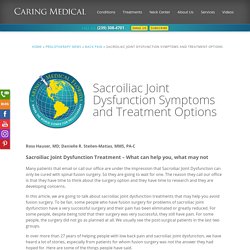
Steilen-Matias, MMS, PA-C Sacroiliac Joint Dysfunction Treatment – What can help you, what may not Many patients that email or call our office are under the impression that Sacroiliac Joint Dysfunction can only be cured with spinal fusion surgery. So they are going to wait for one. The reason they call our office is that they have time to think about the surgery option and they have time to research and they are developing concerns. In this article, we are going to talk about sacroiliac joint dysfunction treatments that may help you avoid fusion surgery. In over more than 27 years of helping people with low back pain and sacroiliac joint dysfunction, we have heard a lot of stories, especially from patients for whom fusion surgery was not the answer they had hoped for. I still have a lot of pain in my low back and hip. Or – I had a fusion at L5/S1 it resulted in terrible SI joint pain. I had SI fusion three years ago. Study outline: Suggestion of treatments Dr. Sacroiliac Joint Dysfunction Symptoms and Treatment Options – Caring Medical Florida.
Knee (Pes Anserine) Bursitis: Exercises. Introduction Here are some examples of exercises for you to try.
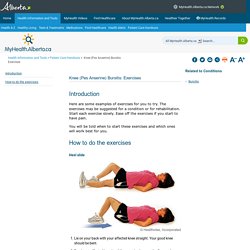
The exercises may be suggested for a condition or for rehabilitation. Ergonomic Exercises. These work posture exercises or It is a good idea to take a break of a few minutes for every hour.

These ergonomic exercises can be done during these mini breaks to prevent computer injuries. Do these exercises a few times. Valerian Root Tincture Recipe. How To Treat Patellar Tendonosis. A couple of weeks ago I wrote about my personal experience in how I recognised I was suffering from patellar tendonitis.
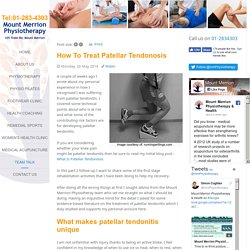
I covered some technical points about who is at risk and what some of the contributing risk factors are for developing patellar tendonitis. If you are considering whether your knee pain might be patellar tendonitis then be sure to read my initial blog post - What Is Patellar Tendonosis In this part 2 follow-up I want to share some of the first stage rehabilitation activities that I have been doing to help my recovery. After doing all the wrong things at first I sought advice from the Mount Merrion Physiotheray team who set me straight on what I should be doing. Having an inquisitive mind for the detail I asked for some evidence-based literature on the treatment of patellar tendonitis which I duly studied and supports my personal account here.
What makes patellar tendonitis unique I am not unfamiliar with injury thanks to being an active bloke. Robin. Get to the Bottom of “Dead Butt Syndrome“ A few months ago, I evaluated a patient who was referred to our clinic for "Dead Butt Syndrome".

She felt pretty hopeless at ever gaining back what was left of her butt and being able to do every day activities without pain. I explained how it is a result of muscle compensations and is very typical in many individuals treated at our clinic. What exactly is it and how is it treated? Dead Butt Syndrome is another way to describe weakness in the glutes, particularly the gluteus medius on the outside of the hip. Piriformis Trigger Point Referral Patterns. Piriformis Sections: About the Piriformis Trigger points in the piriformis are very common, and are usually involved to some extent anytime there is pain in and coming from the gluteal/pelvic region.
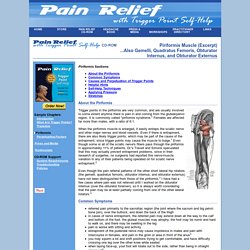
It is commonly called "piriformis syndrome. " Females are affected far more than males, with a ratio of 6:1. Pph22 3p1 3. Obturator Internus. Obturator internus can be used to widen the sitting bones, pulling them away from each other and also away from the sacrum and tailbone.
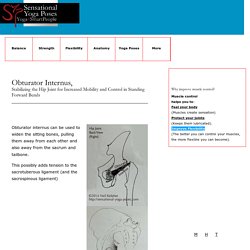
This possibly adds tension to the sacrotuberous ligament (and the sacrospinous ligament) Adding Tension to the Sacrotuberous Ligament The sacrotuberous ligament connects the sitting bones to the sacrum. Effects of Individual Strengthening Exercises on Subdivisions of the Gluteus Medius in a Patient with Sacroiliac Joint Pain. Pelvic Drop Exercise to Improve Hip Strength. How Hip Weakness May Contribute to Knee Pain. If you have knee pain or problems, your physical therapist may pay close attention to your hips and the strength of your hip muscles.
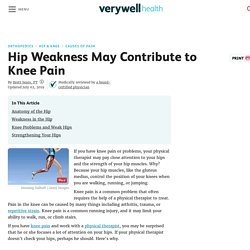
Why? Because your hip muscles, like the gluteus medius, control the position of your knees when you are walking, running, or jumping. Knee pain is a common problem that often requires the help of a physical therapist to treat. Pain in the knee can be caused by many things including arthritis, trauma, or repetitive strain. Knee pain is a common running injury, and it may limit your ability to walk, run, or climb stairs. A Tight Psoas and Pinched Sacroiliac Joint. All too many people have a tight psoas muscle if not two tight psoas muscles.
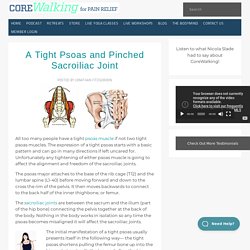
The expression of a tight psoas starts with a basic pattern and can go in many directions if left uncared for. Unfortunately any tightening of either psoas muscle is going to affect the alignment and freedom of the sacroiliac joints. The psoas major attaches to the base of the rib cage (T12) and the lumbar spine (L1-40) before moving forward and down to the cross the rim of the pelvis. It then moves backwards to connect to the back half of the inner thighbone, or femur.
The sacroiliac joints are between the sacrum and the ilium (part of the hip bone) connecting the pelvis together at the back of the body. Iliopsoas Syndrome: The Hidden Root of Pain. The Hidden Prankster The iliopsoas muscle is one of the most complex muscles in the body.
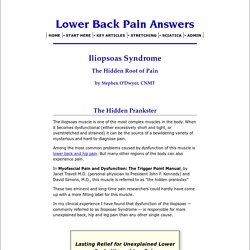
When it becomes dysfunctional (either excessively short and tight, or overstretched and strained) it can be the source of a bewildering variety of mysterious and hard-to-diagnose pain. Among the most common problems caused by dysfunction of this muscle is lower back and hip pain. But many other regions of the body can also experience pain. In Myofascial Pain and Dysfunction: The Trigger Point Manual, by Janet Travell M.D. Assessment Female.Symptom Monitor.
Internal pelvic floor self massage guide. Anterior Pelvic Tilt and Pelvic Floor Dysfunction - Breathing Exercise. External Massage for Pelvic Floor Pain - Trigger Point Myofascial Release. Massage and myofascial release can be one of the most useful tools for fighting chronically tight and painful pelvic floor muscles. When the muscles of the pelvis are chronically tight or spasm'ing non stop throughout the day this can leave the muscles tightly bound and full of painful trigger points. External massage can be especially useful for people who are a bit squeamish about doing an internal massage on themselves. Its a great place to start exploring your pelvic floor , finding your trigger points and bringing you some relief. Finally time to start healing the pelvic floor. High Tone Pelvic Floor Dysfunction. Too much of a good thing With all of the focus on strengthening the pelvic floor, there seems to be a silent epidemic of inflexibly tight pelvic floor muscles.
You’ll see advice (which I don’t agree with) to ”do 100 kegels in the car on the way to work”, but with no relaxation component. Active relaxation is as important as muscle strengthening. Tight or spasmed pelvic floor muscles are as dysfunctional as weak pelvic floor muscles, and can be lead to intense pain during vaginal penetration, orgasm and even difficulty with comfortable bowel movements. The Pelvic Floor-Overactive or Underactive? – NeuroKinetic Therapy® Weakness of the pelvic floor muscles is associated with lower back pain, incontinence, constipation, and sexual dysfunction. The use of Kegel exercises to correct this is commonplace and widely utilized by physical therapists and Pilates instructors. When employed correctly these exercises can strengthen the core, the lower back, and the pelvic organs. Hip Stretches - It is common to develop muscle imbalances around the hip.
Why do We do Hip Stretches? The hip is a very stable ball and socket type joint with an inherently large range of motion. The hip contains some of the largest muscle in the body as well as some of the smallest. Most people lack mobility due to a relatively sedentary lifestyle. How To Use Videos / SI Joint. NERVE ENTRAPMENT IN THE HIP REGION: CURRENT CONCEPTS REVIEW. Hamstring Injuries Resulting from Sacroiliac Dysfunction. The hamstring muscle complex is the most commonly strained muscle complex of the thigh, and possibly one of the most common sports injuries. To assess and treat hamstring injuries, a differentiation must be made as to whether the cause is direct and acutely traumatic, or whether the injury is a common resultant from a gradual onset. This can be confusing, because a gradual onset hamstring strain, which is subclinical, may become clinically manifest with increased activity and may be regarded as traumatic.
In these cases, it really is still a chronic and gradual onset, ultimately intensified by intensive activity and rendered clinically symptomatic. It is necessary to classify hamstring strains as direct traumatic and abrupt strains, gradual onset strains, or those related to hereditarily tight muscles. Chronic sacroiliac joint and pelvic girdle dysfunction in a 35-year-old nulliparous woman successfully managed with multimodal and multidisciplinary approach. High Tone Pelvic Floor Dysfunction.
Chronic sacroiliac joint and pelvic girdle dysfunction in a 35-year-old nulliparous woman successfully managed with multimodal and multidisciplinary approach. Understanding Pelvic Floor Movement. By Katie Hunter Drop, push, bulge, squeeze. How To Use Videos / SI Joint. Spinal Muscles: A Comprehensive Guide. Three-Dimensional Modeling of the Pelvic Floor Support Systems of Subjects with and without Pelvic Organ Prolapse. Patient Portal. Female Pelvic Floor Anatomy: The Pelvic Floor, Supporting Structures, and Pelvic Organs.
Salli. Traditional sitting on a chair with 90° degree angles in hips and knees inevitably makes people slouch. When sitting on a saddle chair the thighs are in a 90° degree angle in relation to each other and pointing downwards in an approximately 45° degree angle. The pelvis is tilting forward, not backward, like in traditional sitting. Evaluation of the Patient with Hip Pain. 1. Christmas C, Crespo CJ, Franckowiak SC, et al. Diagnosis and Management of Piriformis Syndrome: An Osteopathic Approach. Kinesiology Tape Instructions. Unlike traditional athletic tape that is wrapped tightly around an injured area, kinesiology tape is applied in shorter strips that are placed either directly over injured joints and muscles or around their borders. Depending on the type of injury, these strips can be applied in a variety of shapes, sizes and configurations, allowing each application to be customized to the exact needs for each situation.
I-Strips, X-Strips, Y-Strips and Edema or Fan Strips are the building blocks of kinesiology taping. With these 4 shapes, you can create an application for almost any injury or medical condition. The Downside … and the Solution! The downside is that the more complicated your kinesiology taping applications are, the more time-consuming it becomes to cut the tape into these different configurations. Differentiating hip pathology from lumbar spine. Relieving Symptoms of Meralgia Paresthetica Using Kinesio Taping: A Pilot Study - Archives of Physical Medicine and Rehabilitation.
Because applying KT may affect the fascia around the lateral femoral cutaneous nerve, it is a potentially effective method for relieving symptoms in patients with MP. Kinesiology Tape Instructions. A Primer on Kinesiology Tape III - Rehab U. Differentiating hip pathology from lumbar spine. Iliopsoas Syndrome - How to Calm this "Hidden Prankster" Ischial tuberosity pain and ischiofemoral impingement – Caring Medical.
Ross Hauser, MD In this article we will describe Ischial tuberosity pain and ischiofemoral impingement. Focus will be on two types of problems. How to address ischiofemoral impingement? Treatment algorithm and review of the literature. Sacroiliac Joint Dysfunction - Sacroiliac Joint Pain. Common diseases mimicking lumbar disc herniation and their treatment. Gray344 - Obturator nerve. Obturator Internus: Out of Sight, but Keep It in Mind - H3 By Dan Hellman. Chronic pelvic pain arising from dysfunctional stabilizing muscles of the hip joint and pelvis. Obturator Internus Dysfunction — Zion Physical Therapy. High Tone Pelvic Floor Dysfunction.
Come Again? An Orgasm Guide. Biology of Female Sexual Function » Sexual Medicine » BUMC. Leg Exercises for Bad Knees: Stretch and Strengthen. Slideshow: Exercises to Help Knee Pain in Pictures. Calf Stretches: Improve Flexibility. Foot & Ankle Strengthening Exercises. 16 Tips for Desk Jockeys: What to Do About Sitting All Day. How to Undo the Damage of Sitting - 7 Simple Exercises.
Shoes, Sitting, and Lower Body Dysfunctions – Steven Low. 12 Hip Stretches Your Body Really Needs. Slideshow: Exercises to Help Knee Pain in Pictures. 6 Vastus Medialis Exercises: To Stabilize and Protect the Knee. Correcting Common Posture For Lumbar Stenosis – ThePostureGuy. Pudendal Neuralgia. Exercises for Pudendal Nerve Entrapment.
Pudendal Neuralgia. Two additional PGAD accounts - Women's Healthcare. 'I get constant sexual arousal and this condition is ruining my life' Mind-Body Case Story: Part 1 — Pelvic Floor & Yoga Physical Therapy. EP7. Fix Anterior Pelvic Tilt In 3 EASY STEPS! APT Workout Video. 5 Steps for Dealing With Anterior Pelvic Tilt. Paving the Way for a Healthy Pelvic Floor. Ws24 apadoa. Recognizing Myofascial Pelvic Pain in the Female Patient with Chronic Pelvic Pain. Piriformis Syndrome Causes & How Pain Increases Via This Vicious Cycle. Piriformis: Is it really tight? Really? - NASM Blog. The Do’s and Don’ts of Sacroiliac Dysfunction. Neurologic Factors in Female Sexual Function and Dysfunction.
Come Again? An Orgasm Guide. How To Beat Piriformis Syndrome – PodiumRunner. Treatment. Patellofemoral Pain Syndrome: A Review and Guidelines for Treatment.